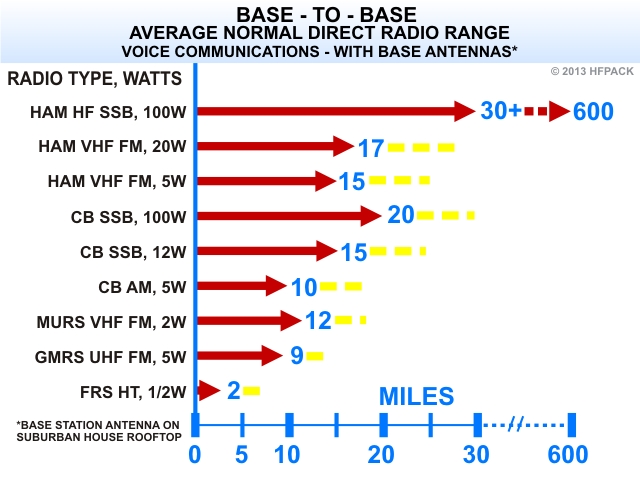

HF Digital Messaging - Emergency / Disaster Relief - Interoperative Communications - Ham Radio
















"How far will that radio go?"
"What type of radio should I get for most range?"
These simple questions often lead to complex answers because so many factors influence the distance of radio communications. To simplify, the following charts show how many miles you can usually communicate over normal terrain in suburban or rural areas with different types of radios, power levels, and station configurations. The graphs compare the most commonly available 2-way radios such as ham, CB, FRS, MURS, and GMRS. Some radio gear advertisements tout the maximum possible distance in perfect conditions, an often misleading specification. In the real world, people want to know the normal dependable average range of a radio. Here it is:
"What type of radio should I get for most range?"
These simple questions often lead to complex answers because so many factors influence the distance of radio communications. To simplify, the following charts show how many miles you can usually communicate over normal terrain in suburban or rural areas with different types of radios, power levels, and station configurations. The graphs compare the most commonly available 2-way radios such as ham, CB, FRS, MURS, and GMRS. Some radio gear advertisements tout the maximum possible distance in perfect conditions, an often misleading specification. In the real world, people want to know the normal dependable average range of a radio. Here it is:


The above graph shows the distance
range between two base stations using a basic antenna mounted on the
roof of a suburban house with a height of about 20ft above ground
level. Communication distance can be greatly
improved over this by advanced gain antenna systems or a high pole or a
tower. This estimate is based upon radio-to-radio direct communications
without the use of a repeater.

The above graph shows the distance range between a mobile vehicle with a basic vehicle antenna, communicating with a base
station using a basic antenna mounted on the roof of a suburban house. Communication
distance can be greatly improved over this by advanced gain antenna
systems or a high pole or a tower at the base station. The distance can
be adversely affected by interference from the vehicle engine; further
distance can be achieved by parking on a hilltop or open area and
shutting off the vehicle. This estimate is based upon radio-to-radio direct communications without the use of a repeater.

The above graph shows the distance range between two mobile vehicles with basic vehicle whip antennas. Communication
distance can be somewhat improved (25%to 50% further) over this on VHF and UHF by the use of a gain antenna. The distance can be adversely affected by interference from
the vehicle engine; further distance can be achieved by parking on a
hilltop or open area and shutting off the vehicle. This estimate is based upon radio-to-radio direct communications without the use of a repeater.

The above graph shows the distance
range between a pedestrian with a whip antenna and a mobile vehicle
with a basic vehicle whip antenna. HF backpack radios, HF packs, CB
backpack radios, or manpack radios are compared with Handy Talkies,
Walkie Talkie, or HT radios. Communication
distance can be somewhat improved (25%to 50% further) over this on VHF and UHF by the use of a gain antenna on the vehicle. Distance on VHF will be somewhat less if a smal rubber ducky
antenna is used on the pedestrian radio instead of a full size antenna. The use of a
counterpoise radial wire on the pedestrian radio improves distance. This estimate is based upon radio-to-radio direct communications without the use of a repeater.

The above graph shows the distance range between two pedestrian radios
with whip antennas. Improved distance can be achieved by standing in an open area or on a hilltop. HF backpack radios, HF packs, CB backpack radios, or manpack
radios are compared with Handy Talkies, Walkie Talkie, or HT radios. Distance
on VHF will be somewhat less if a smal rubber ducky antenna is used
instead of a full size antenna. The use of a counterpoise radial wire on
the pedestrian radio improves distance. This estimate is based upon radio-to-radio direct communications without the use of a repeater.

















END OF PAGE
©2013-2000 HFLINK div of HFpack Inc. All Rights Reserved.
HFLINK, HF-LINK, HF LINK, the HFLINK Logo, and VertaLoop are trademarks of HFpack Inc. Any external hyperlinks must only be to the main page of the HFLINK.COM website http://hflink.com . Capture of the HFLINK website or any part of it within the frame of another website is not permitted. HFLINK group forum is a private group. Public archiving, forwarding, or open display on the internet of HFLINK group forum or messages is forbidden. All text and images on the HFLINK website are property of and copyright HFpack Inc, or when used by permission, are copyright by their respective owners. All rights reserved.
HFN and High Frequency Network are service marks and trademarks of HFpack, Inc. No part of the HFLINK website or HFLINK Group Forum may be used or copied without written permission of HFpack Inc.


